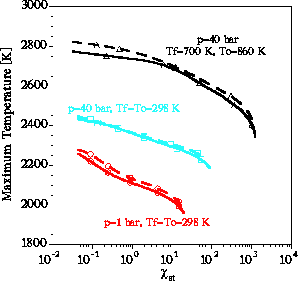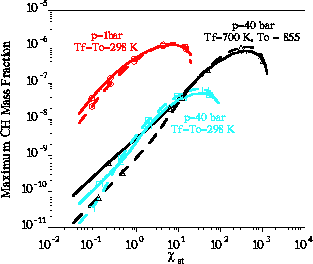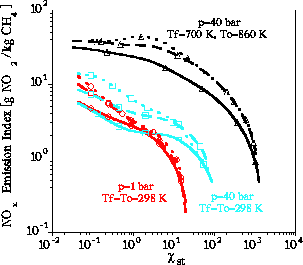

The following plots, taken from [1], compare the calculations using
the reduced mechanisms and the skeletal mechanism. Calculations are
performed for methane-air counterflow diffusion flames at (RED) p = 1 bar, Tf = To = 298 K, ((CYAN) p = 40 bar, Tf = To = 298 K,
and (BLACK) p = 40 bar, Tf = 700 K, To = 860 K. These cases roughly
correspond to ambient conditions, isothermal compression to 40 bar,
and adiabatic compression to 40 bar. In each case, the solid line
represents the detailed mechanism, the (long) dashed line represents
the most comprehensive reduced mechanism, and the dotted line
represents the reduced mechansism with one-step nitrogen chemistry
(only relevant for the last plot). The units for the scalar
dissipation rate on the abscissa are (1/s).
Peak Flame Temperatures
Maximum CH Mass Fraction
NOx Emission Index



The reduced mechanism is seen to consistently overpredict the
temperature by 10 to 50 K. This results in the overprediction of
production by the thermal mechanism; since the thermal mechanism is
of greater importance for longer residence times, this is evident
primarily for lower scalar dissipation rates.
Prediction of CH is best at high scalar dissipation rates which is
where the prompt mechanism is most important.
With the one-step nitrogen
chemistry, poor steady-state descriptions of intermediates important
in reburn (specifically NH2) results in the underprediction of reburn
relative to the six-step nitrogen chemistry at high pressures.
References
 back one page
back one page
International Workshop on Measurement and Computation of Turbulent
Nonpremixed Flames
combustion home page
![]()
email: jhewson@ames.ucsd.edu
J. Hewson